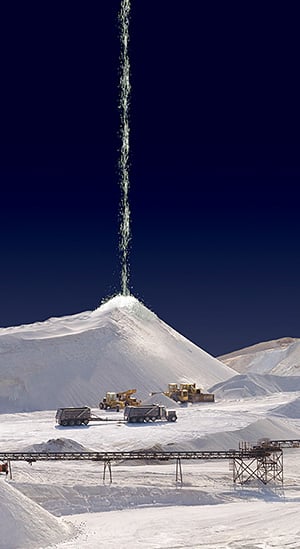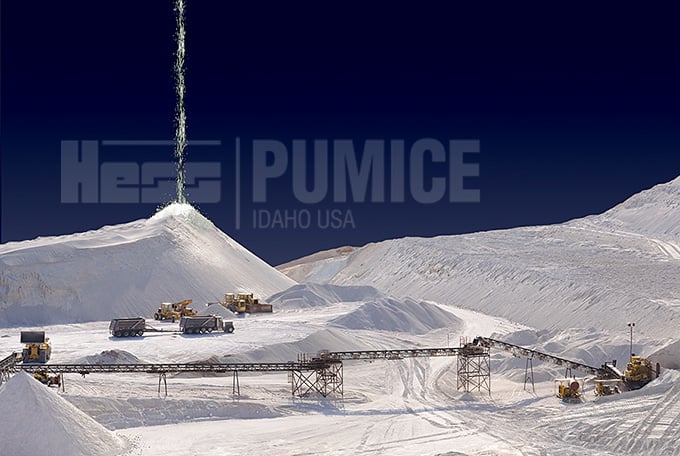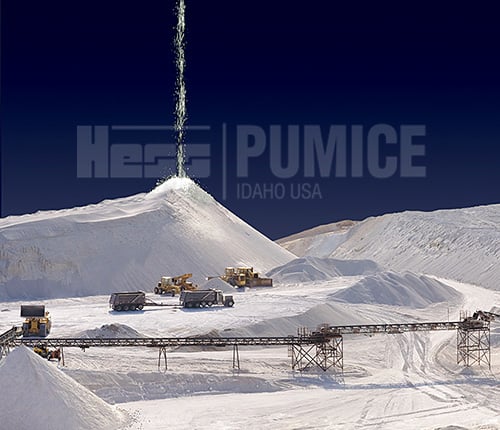BASE INFORMATION
About Pumice
Deep in the fiery heart of a volcano, immense pressures force water to mix with magma, the super-heated mixture swelling and fighting for release, driving relentlessly up through fissures and faults in the layers of confining rock and earth. The resulting eruption is both violent and spectacular, launching the moisture-infused magma high into the atmosphere, where the trapped water flashes to steam, foaming the cooling molten rock into a glassy froth. What falls back to earth is pumice—amorphous, friable, yet tough—an ideal form factor for a variety of industrial processes and consumer products.
Pumice Mining and Processing
Mining pumice is, environmentally speaking, a low-impact process. Most pumice is surface-mined. The soil (overburden) covering the pumice is pushed aside and stockpiled for later reclamation of the mining site. The pumice is ripped or scraped loose and pushed to the crusher for preliminary processing (mine grades). The feed-stock grades are loaded and trucked to the plant for additional processing.
The pumice is conveyed through a dryer to reach the ideal moisture content for refining and flow, then lifted high into the plant to run down through the crushers, shakers and screens, separated by grade, blended with other grades as needed, and finally packaged or bulk loaded for delivery.
Mohs Hardness Scale
Pumice is light and frothy-hard—hard enough to function as a gentle abrasive in clean-and-polish applications, yet friable enough to hold its effective foamed-glass character even when crushed to fine powder grades. And while many minerals of comparable hardness are available to industry, they are crystalline in structure and relentlessly dense. Pumice has a non-crystalline, amorphous structure, meaning no respirable silica issues. Hess pumice classifies as a six on the Mohs hardness scale: plenty hard, but with structural give.
| MOHS HARDNESS SCALE | |
| MATERIAL | MOHS HARDNESS |
| Talc | 1 |
| Fluorite | 4 |
| Feldspar | 6 |
| Pumice (Hess Deposit) | 6 |
| Quartz | 7 |
| Diamond | 10 |
| Ranked on the Mohs Hardness Scale, Talc is the softest, Diamond the hardest. | |
Chemical Makeup of Pumice
Pumice is not created equally—it varies greatly in its chemical properties (and usefulness) from deposit to deposit, but essentially, pumice is primarily Silicon Dioxide (Amorphous Aluminum Silicate), some Aluminum Oxide, and trace amounts of other oxides. Hess pumice is chemically inert, pH neutral, and free from heavy metals.
See the Why Source Pumice from Hess? site page for a detailed breakdown of Hess’ pumice—the key features and tabled Chemical Analysis and Physical Properties information.
Pumice Grades
We produce over 70 pumice grades and grade blends and stock sample and small-order quantities of the most popular pumice grades, ready to ship anywhere in the world. For large orders and specialized grades and grade blends, allow for a 2-week production time to ready for shipment. If we do not have a product in our grade catalog that meets a particular need, we are happy to work with customers to work up custom grades or grade blends.
See the Pumice Grades and Types site page for more information on grade types and packaging.


